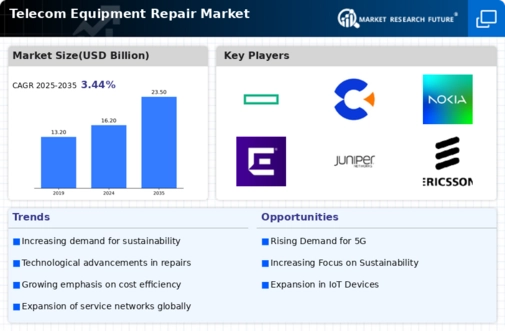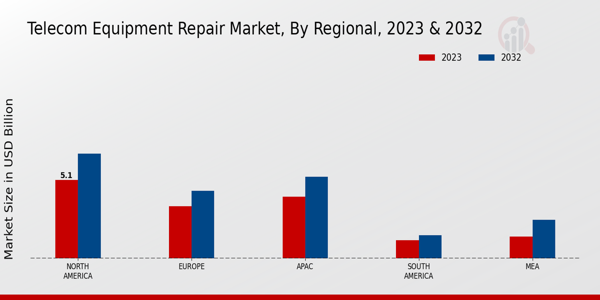Market Growth Projections
The Global Telecom Equipment Repair Market Industry is projected to experience substantial growth over the coming years. With a market value of 16.2 USD Billion in 2024, it is anticipated to reach 23.5 USD Billion by 2035. This growth trajectory suggests a compound annual growth rate (CAGR) of 3.44% from 2025 to 2035. Such projections indicate a robust demand for repair services as the telecommunications sector continues to expand and evolve. Factors contributing to this growth include technological advancements, increasing network complexity, and a heightened focus on reliability and sustainability.
Growing Focus on Sustainability
Sustainability is becoming an increasingly important consideration within the Global Telecom Equipment Repair Market Industry. As environmental concerns rise, telecom companies are seeking to implement eco-friendly practices in their operations, including repair services. This shift towards sustainability may involve the use of recyclable materials and energy-efficient repair processes. Companies that adopt these practices not only contribute to environmental preservation but also appeal to a growing segment of environmentally conscious consumers. This trend is expected to influence market dynamics, as sustainability initiatives become integral to business strategies in the telecom repair sector.
Regulatory Compliance and Standards
Regulatory compliance plays a crucial role in the Global Telecom Equipment Repair Market Industry. Governments and regulatory bodies impose stringent standards to ensure the safety and reliability of telecom equipment. Compliance with these regulations often requires regular maintenance and repair services, driving demand within the market. Companies that prioritize adherence to these standards not only mitigate risks but also enhance their reputation among consumers. As the regulatory landscape continues to evolve, the need for compliant repair services is likely to grow, further propelling market expansion and fostering a culture of accountability within the industry.
Rising Complexity of Telecom Equipment
The increasing complexity of telecom equipment is a notable driver for the Global Telecom Equipment Repair Market Industry. As networks evolve to incorporate advanced technologies such as 5G and IoT, the intricacies of equipment repair also escalate. This complexity necessitates specialized knowledge and skills for effective maintenance and repair services. Consequently, service providers are compelled to enhance their capabilities to address these challenges. The market is anticipated to grow to 23.5 USD Billion by 2035, reflecting the ongoing need for expertise in managing sophisticated telecom systems and ensuring their optimal performance.
Increasing Demand for Network Reliability
The Global Telecom Equipment Repair Market Industry is experiencing heightened demand for network reliability as telecommunications infrastructure becomes increasingly critical. As businesses and consumers alike rely on uninterrupted connectivity, the need for efficient repair services grows. In 2024, the market is projected to reach 16.2 USD Billion, reflecting a robust response to this demand. Companies are investing in maintenance and repair solutions to minimize downtime and ensure seamless operations. This trend is likely to continue, as the industry adapts to the evolving landscape of telecommunications, where reliability is paramount for both service providers and end-users.
Technological Advancements in Repair Techniques
Technological advancements are significantly shaping the Global Telecom Equipment Repair Market Industry. Innovations in repair techniques, such as the use of artificial intelligence and machine learning, enhance diagnostic capabilities and streamline repair processes. These technologies enable quicker turnaround times and more accurate assessments of equipment issues. As a result, repair services can operate more efficiently, reducing costs and improving customer satisfaction. The integration of advanced tools and methodologies is expected to drive market growth, with a projected CAGR of 3.44% from 2025 to 2035, indicating a sustained investment in technological improvements.









